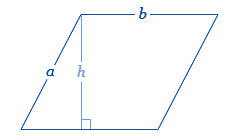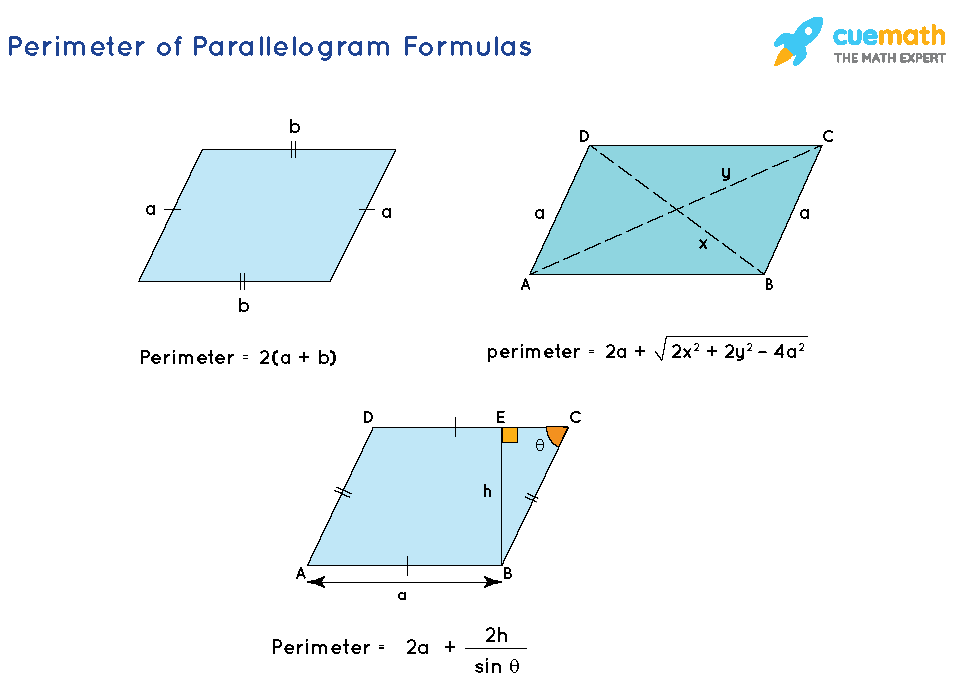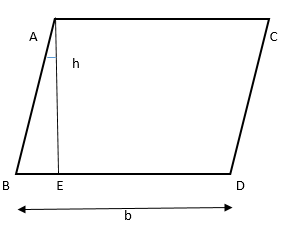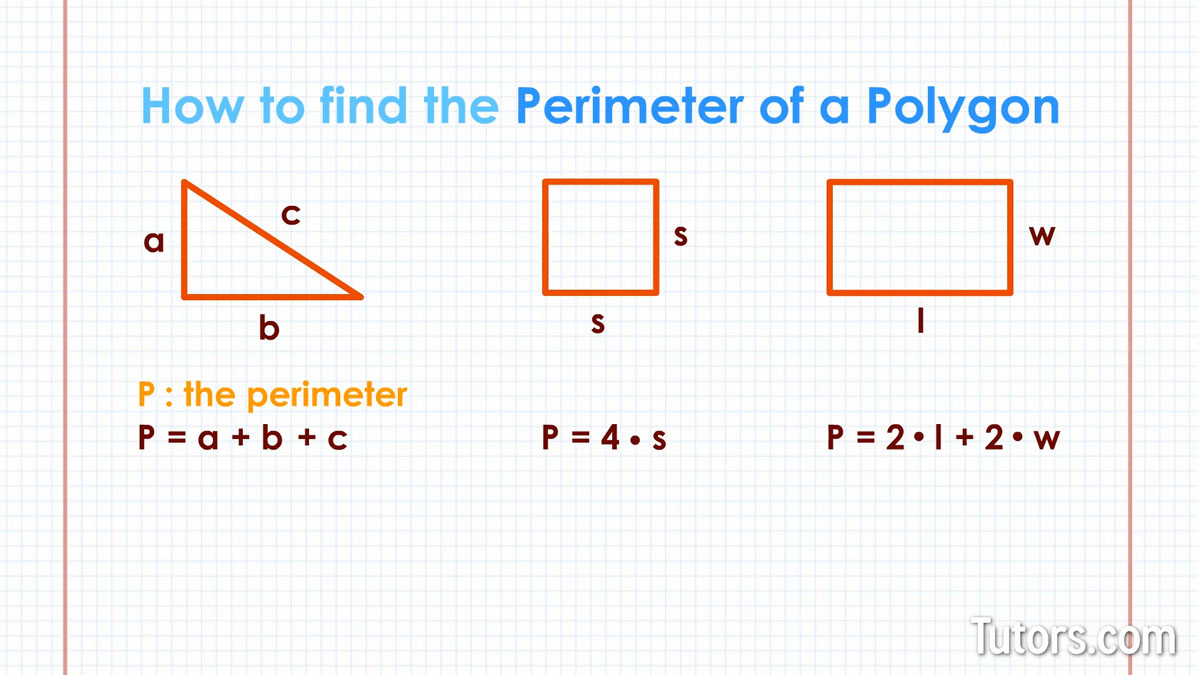Topic what is the perimeter of this parallelogram: Discover the fascinating world of geometry with our guide to understanding the perimeter of a parallelogram. This essential geometric concept is not only intriguing but also incredibly useful in various mathematical and practical applications.
Table of Content
- Definition and Basic Properties of a Parallelogram
- YOUTUBE: Finding the Perimeter of a Parallelogram
- Standard Formula for Parallelogram Perimeter
- Calculating Perimeter with Diagonals and Angle
- Using Base, Height, and Angles for Perimeter Calculation
- Examples and Practice Problems
- Understanding Supplementary Angles in Parallelograms
- Interactive Tools for Learning Parallelogram Perimeter
- Applications of Parallelogram Perimeter in Real Life
- Worksheets and Additional Resources
- Frequently Asked Questions
Definition and Basic Properties of a Parallelogram
A parallelogram is a unique and fascinating four-sided shape in geometry, characterized by its parallel opposite sides. This flat shape is notable for its equal and parallel opposing sides, making it a distinct member of the quadrilateral family. The properties of a parallelogram set it apart from other geometric shapes and form the basis for understanding its perimeter and area.
- Opposite Sides are Parallel and Equal: In a parallelogram, each pair of opposite sides is not only parallel to each other but also of equal length.
- Opposite Angles are Equal: Another defining characteristic is that opposite angles within a parallelogram are equal.
- Consecutive Angles are Supplementary: Each pair of consecutive (adjacent) angles in a parallelogram adds up to 180 degrees, meaning they are supplementary.
- Diagonals Bisect Each Other: The diagonals of a parallelogram intersect each other at their midpoints, effectively bisecting each other.
Understanding these basic properties is crucial in determining the perimeter of a parallelogram. The perimeter is the total distance around the boundary of the shape, calculated by adding the lengths of all its sides. For a parallelogram, this can be simplified due to the equality of opposite sides.

READ MORE:
Finding the Perimeter of a Parallelogram
\"Discover the secrets of calculating perimeter in our engaging video tutorial! Learn how to find the total distance around a shape and how this concept is applied in real-life scenarios. Join us now and become a master of perimeter calculation!\"
Standard Formula for Parallelogram Perimeter
The perimeter of a parallelogram is the total distance around the shape. Since a parallelogram has four sides, its perimeter is the sum of all these sides. A unique property of a parallelogram is that the opposite sides are parallel and equal in length. Thus, if the lengths of two adjacent sides are known, the perimeter can be easily calculated.
Basic Formula
The basic formula for the perimeter of a parallelogram, when the lengths of its adjacent sides are known (let\"s call them \"a\" and \"b\"), is:
Perimeter (P) = 2(a + b)
Example
For instance, if one side (a) is 10 cm and the other side (b) is 5 cm, the perimeter (P) would be:
P = 2(a + b) = 2(10 + 5) = 2 × 15 = 30 cm
Perimeter with Diagonals and Angle
If the lengths of the diagonals (x and y) and one side (a) of the parallelogram are known, the perimeter can be calculated using this formula:
P = 2a + √[2(x² + y² - 2a²)]
Perimeter with Base, Height, and Angle
In a scenario where the base (a), height (h), and an interior angle (θ) of the parallelogram are given, the perimeter can be found as follows:
P = 2a + 2h / sin θ
This formula uses the sine function in trigonometry to calculate one of the sides based on the height and the angle.

Perimeter of a Parallelogram: Geometry Lesson | Khan Academy
\"Unravel the fascinating world of geometry with our mind-blowing video lesson! Dive into the realm of shapes, angles, and spatial relationships as we explore the core principles of this mathematical field. Get ready to be captivated by the beauty of geometry!\"
Calculating the Area of Parallelograms
\"Unlock the mysteries of area calculation in our captivating video presentation! Delve into the realm of measuring two-dimensional space and uncover the significance of area in various contexts. Get ready to embark on an enlightening journey into the world of shapes and sizes!\"
Calculating Perimeter with Diagonals and Angle
The perimeter of a parallelogram can also be calculated using its diagonals and an interior angle. This method is particularly useful when the lengths of the sides are not known but the diagonals and an angle are available.
Formula Involving Diagonals and One Side
When one side (a) and the diagonals (x and y) of the parallelogram are known, the perimeter (P) can be calculated using the formula:
P = 2a + √[2(x² + y² - 2a²)]
This formula is derived from the properties of a parallelogram and the Pythagorean theorem.
Formula Involving Base, Height, and Angle
If the base (a), height (h), and an interior vertex angle (θ) of the parallelogram are known, another formula for the perimeter can be used:
P = 2a + 2h / sin θ
This formula utilizes trigonometry, specifically the sine function, to determine the length of the side opposite to the given angle.
Examples
- Example 1: Given a parallelogram with side 7 units and diagonals 8 and 10 units, the perimeter is calculated as:
- P = 2a + √(2x² + 2y² - 4a²) = 2 × 7 + √(2(8)² + 2(10)² - 4(7)²) ≈ 25.49 units
- Example 2: For a parallelogram with a side of 15 yards, a height of 20 yards, and a vertex angle of 30 degrees, the perimeter is:
- P = 2a + 2h / sin θ = 2 × 15 + 2 × 20 / sin 30° = 110 yards

Using Base, Height, and Angles for Perimeter Calculation
The calculation of the perimeter of a parallelogram using its base, height, and angles involves a few geometric principles and trigonometry. This method is particularly useful when the lengths of the sides are not directly known. Below is a step-by-step guide on how to calculate the perimeter using these parameters.
- Understanding the Parallelogram: A parallelogram is a four-sided figure with opposite sides that are parallel and equal in length. The angles between the sides are typically not right angles.
- Identifying Base and Height: The base of the parallelogram is any of its sides, and the height is the perpendicular distance from the base to the opposite side. Note that the height is not the length of the side itself unless the parallelogram is a rectangle.
- Calculating Side Lengths Using Trigonometry: If you know one side length (base) and the height, you can calculate the other side length using trigonometric ratios. For instance, if you know the angle adjacent to the base, you can use the sine, cosine, or tangent functions to find the length of the adjacent side.
- Applying the Perimeter Formula: The perimeter of a parallelogram is the sum of the lengths of all its sides. Since opposite sides are equal, the perimeter P can be calculated as P = 2(a + b), where a and b are the lengths of the adjacent sides.
- Example Calculation: Suppose you have a parallelogram with a base of 10 units, a height of 5 units, and an acute angle of 60 degrees. You can calculate the length of the adjacent side using the sine function (sin 60° = opposite/hypotenuse), and then compute the perimeter.
Remember, the key to this method is a good understanding of basic trigonometry and geometry. Once you have the side lengths, calculating the perimeter is straightforward.
Practical Tips:
- Always double-check your angle measurements and side lengths for accuracy.
- Use a scientific calculator for trigonometric calculations to ensure precision.
- Practice with different parallelograms to get comfortable with the method.
With these steps, you should be able to calculate the perimeter of a parallelogram using its base, height, and angles accurately and efficiently.

Examples and Practice Problems
Understanding the perimeter of a parallelogram can be enhanced through practical examples and exercises. Let’s explore some solved examples that illustrate how to calculate the perimeter in different scenarios.
Example 1: Basic Perimeter Calculation
Calculate the perimeter of a parallelogram with side lengths of 7 cm and 8 cm.
- Let the lengths of the sides be a = 7 cm and b = 8 cm.
- Using the formula P = 2(a + b), the perimeter P = 2(7 + 8) = 2(15) = 30 cm.
Result: The perimeter of the parallelogram is 30 cm.
Example 2: Decorating a Doll House
Meg wants to decorate her doll house, which is in the shape of a parallelogram, with dimensions 60 cm by 20 cm.
- Consider the dimensions as a = 60 cm and b = 20 cm.
- Using P = 2(a + b), we find P = 2(60 + 20) = 2(80) = 160 cm.
Result: Meg will need 160 cm of wire to decorate her doll house.
Example 3: Finding the Unknown Side
The perimeter of a comic book, shaped like a parallelogram, is 50 cm. One of its sides is 15 cm. Determine the length of the other side.
- Given, perimeter P = 50 cm and one side a = 15 cm.
- Using the formula P = 2(a + b), 50 = 2(15 + b).
- Solving, we find b = 10 cm.
Result: The length of the other side of the comic book is 10 cm.
Practice Problems
- Find the perimeter of a parallelogram with sides 12 cm and 9 cm.
- A parallelogram shaped notebook has a perimeter of 44 cm. If one side is 10 cm, find the other side.
- Calculate the perimeter of a parallelogram with a side length of 7 cm and diagonals of 9 cm and 11 cm.
- Determine the perimeter of a parallelogram where one side is 12 ft, the corresponding height is 8 ft, and one of the vertex angles is 30 degrees.

_HOOK_
Understanding Supplementary Angles in Parallelograms
Supplementary angles are a fundamental aspect of parallelograms, crucial for understanding their geometric properties. In a parallelogram, each pair of consecutive (or adjacent) angles are supplementary, meaning their measures add up to 180 degrees.
What Are Supplementary Angles?
Supplementary angles are two angles whose measures add up to 180 degrees. This characteristic is essential in understanding the internal angles of parallelograms.
Supplementary Angles in Parallelograms
- In any parallelogram, the consecutive angles are supplementary. This means that if you take any two adjacent angles, their sum will be 180 degrees.
- This property can be demonstrated through geometric proofs involving parallel lines and alternate interior angles.
- For instance, in a parallelogram ABCD, angles ∠A and ∠B are consecutive. Hence, ∠A + ∠B = 180°. Similarly, ∠C + ∠D = 180°.
Examples and Application
- Example 1: If one angle of a parallelogram measures 75°, the measure of its adjacent angle would be 105°, as they must add up to 180°.
- Example 2: In a scenario where the values of opposite angles of a parallelogram are given as ∠1 = 75° and ∠3 = (x + 30)°, solving for x would yield x = 45°, as opposite angles in a parallelogram are equal.
Understanding the supplementary nature of consecutive angles in parallelograms helps solve various geometric problems, especially those involving calculations of unknown angles and sides. It\"s a key concept in the study of geometry and is applicable in various real-world scenarios, such as architecture and engineering.

Interactive Tools for Learning Parallelogram Perimeter
Learning the perimeter of a parallelogram can be engaging and effective with the use of interactive tools. Below are some resources that offer various interactive experiences to deepen understanding of parallelogram perimeters.
1. Polypad – Virtual Manipulatives by Mathigon
Polypad provides a versatile platform with various mathematical manipulatives. It includes features for geometry, allowing learners to explore shapes, including parallelograms. Tools like resizing algebra tiles, setting scale factors for polygons, and geometry construction tools aid in understanding the relationships between different geometrical properties, including perimeters. More info
2. PhET Interactive Simulations
PhET offers interactive simulations for learning various mathematical concepts. It allows students to create shapes and explore the relationship between area and perimeter, which can be particularly useful for understanding parallelograms. More info
3. Interactive Parallelogram by Math Warehouse
This tool allows learners to interact with a parallelogram by dragging its points. As the shape changes, its properties, including angles and sides, update in real time, offering a hands-on way to understand how changes in shape affect the perimeter. More info
4. Geoboard by The Math Learning Center
Geoboard is an online tool for exploring various geometric concepts. By stretching bands around pegs to form polygons, students can investigate perimeters and areas, making it a suitable tool for studying parallelograms. More info
5. Transum Mathematics
Transum offers a range of mathematical exercises and interactive activities. It provides an engaging way to learn and practice calculating the perimeter and area of parallelograms, among other shapes. More info
Each of these tools offers a unique approach to learning about parallelograms, catering to different learning styles and preferences. They can be used independently or in conjunction with traditional teaching methods to enhance the learning experience.

Applications of Parallelogram Perimeter in Real Life
Understanding the perimeter of parallelograms finds numerous practical applications in various fields of life. Here are some of the key areas where this knowledge is applied:
- Architecture: In architectural design, parallelograms are used to create visually appealing structures. For example, certain buildings might feature parallelogram designs to add a unique aesthetic element.
- Engineering: Parallelograms play a crucial role in the design of mechanical linkages, trusses for bridges and buildings, and other systems requiring parallel motion.
- Art and Fashion: In the world of art and fashion, understanding the perimeter of parallelograms is essential. This concept is used in apparel design, particularly in cutting fabrics, and by artists for precise measurements in their work.
- Astronomy: Astronomers use the concept of perimeter to measure orbits and the movement of planets, helping to understand distances in space.
- Computer Graphics and Gaming: The gaming industry utilizes the principles of area and perimeter in character creation and environment design, ensuring precision in graphical representation.
- Gardening and Construction: Knowing the perimeter is essential in gardening for determining the length of fencing needed, and in construction for calculating the amount of materials required for projects like building a shed or molding around doors and windows.
- Surveying: In land surveying, calculating the perimeter of a piece of land is crucial to determine its boundary and size for fencing or development purposes.
These examples illustrate the wide-ranging importance of understanding parallelogram perimeters, underlining their relevance in both practical and creative fields.

Worksheets and Additional Resources
Worksheets are an effective tool for enhancing understanding of the perimeter of parallelograms. Here are some valuable resources that offer diverse worksheets and activities:
- Basic Perimeter Worksheets: For younger students, there are worksheets focused on calculating the perimeter of parallelograms using integers, decimals, and fractions. These worksheets are designed for students from grade 3 to grade 8, providing a solid foundation in understanding perimeter concepts. (Source: Math Worksheets 4 Kids)
- Advanced Practice Worksheets: As students progress, they can engage with more challenging worksheets that include word problems and geometrical shapes. These worksheets encourage the application of the perimeter formula in diverse contexts, catering to students in higher grades. (Source: Tutoring Hour)
- Interactive Worksheets: For a more dynamic learning experience, there are interactive worksheets available online. These resources allow students to explore parallelogram properties in a hands-on manner, enhancing their learning experience. (Source: Cuemath)
- Comprehensive Worksheet Collections: Extensive collections of parallelogram worksheets offer a range of exercises from identifying parallelograms to solving complex algebraic expressions related to parallelograms. These resources cater to a broad spectrum of learning levels. (Source: Math Worksheets 4 Kids)
These worksheets and resources can be used in a classroom setting or for individual practice at home, providing a versatile approach to learning and mastering the concept of parallelogram perimeters.

READ MORE:
Frequently Asked Questions
The perimeter of a parallelogram is a measure of the total distance around its boundary. To understand and calculate the perimeter, we can consider several aspects and scenarios.
- What is the basic formula for the perimeter of a parallelogram?
- The simplest formula for calculating the perimeter of a parallelogram is based on the lengths of its adjacent sides. If \"a\" and \"b\" represent the lengths of the adjacent sides, the perimeter (P) is given by:
- P = 2(a + b)
- How can the perimeter be calculated using diagonals and a side?
- If the lengths of the diagonals and one side are known, the perimeter can be calculated using the formula:
- P = 2a + √(2x² + 2y² - 4a²)
- where \"a\" is the length of one side, and \"x\" and \"y\" are the lengths of the diagonals.
- Can the perimeter be determined using the base, height, and an angle?
- Yes, using the trigonometric sine function, the perimeter can be calculated as:
- P = 2 × (a + (h/sin(angle)))
- Here, \"a\" is the base length, \"h\" is the height, and \"angle\" is one of the angles of the parallelogram.
- What if only the base and side length are known?
- In this case, the perimeter is simply twice the sum of the base and side length:
- P = 2(b + s)
- Are there any online tools to calculate the parallelogram\"s perimeter?
- Yes, there are several online calculators that can help determine the perimeter of a parallelogram given specific measurements.
- Do the properties of parallelograms affect the calculation of the perimeter?
- Understanding that opposite sides of a parallelogram are equal in length and parallel helps in simplifying the calculation of the perimeter.
These FAQs provide a basic understanding of how to calculate the perimeter of a parallelogram. For more complex shapes or scenarios, it is advisable to consult detailed geometrical resources or online calculators.
Discovering the perimeter of a parallelogram unfolds a fascinating aspect of geometry, blending simplicity with mathematical elegance. This exploration offers invaluable insights for students and enthusiasts alike, enhancing both academic understanding and real-world applications.

_HOOK_









